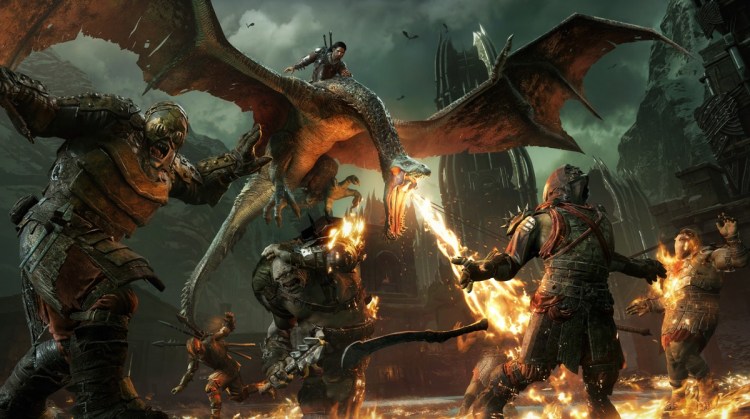Any review of Middle-earth: Shadow of War has to acknowledge that it is a monumental achievement from developer Monolith and publisher Warner Bros. Interactive Entertainment. It’s a huge open world that I have enjoyed exploring over the past dozen days, and I could easily see myself spending many more hours exploring. It is full of new characters, new stories, and new adventures that take place in the 60 years between the events of J.R.R. Tolkien’s The Hobbit and The Lord of the Rings.
Monolith has done a great job fleshing out the culture of the flesh-eating orcs of Mordor. That said, I found some sticky issues that the game raises that aren’t so easy to digest, and they detract from the story’s impact. [Updated] I have finished all of the 63 story-based missions, and I would estimate I’m well into 50 hours of gameplay on my PlayStation 4 review copy.
Middle-earth: Shadow of War is so ambitious that it is clear that Warner Bros. realizes that the time may have come for a video game to carry on the Tolkien legacy.
Editor’s note: This story has narrative spoilers.
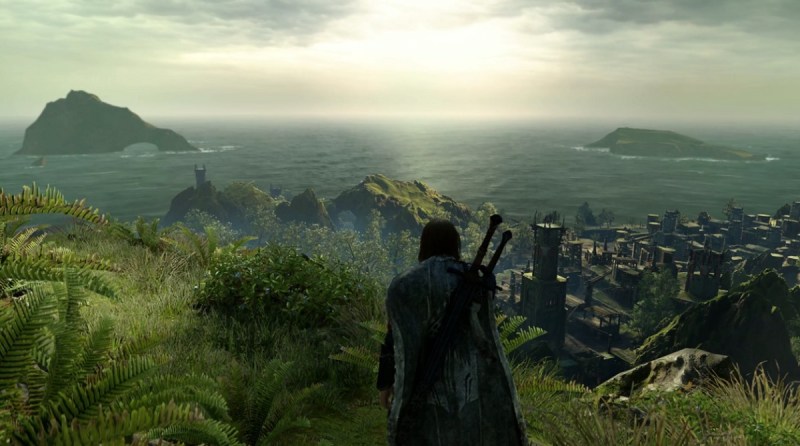
Above: Shadow of War is the sequel to Shadow of Mordor.
Shadow of War (out now for PC, PS4, and Xbox One) is massive, and it should keep you occupied for a long time. It tells a brilliant story of a Ranger, Talion, who is brought back from the dead by the wraith (ghost) of Celebrimbor, a great elven smith whom Sauron deceived into entrapping the world of Middle-earth through the Rings of Power. Celebrimbor wants his revenge, and Talion is his vessel. In the first game, the 2014’s Middle-earth: Shadow of Mordor, Talion uses his powers to start a civil war among the Orcs in an attempt to take the throne from the Dark Lord.
While Talion wants to help people and save lives, Celebrimbor simply wants to amass power to use against Sauron. As a result, Talion doesn’t fully trust Celebrimbor, and that lack of trust is something a temptress, Shelob, exploits. Talion and Celebrimbor begin the second game on Mount Doom, where they forge a new ring for Talion to challenge Sauron. Their challenge to Sauron is clearly going to end in some kind of tragedy, as Talion plays no role in The Lord of the Rings.
What you’ll like
It’s a massive single-player campaign in a huge open world
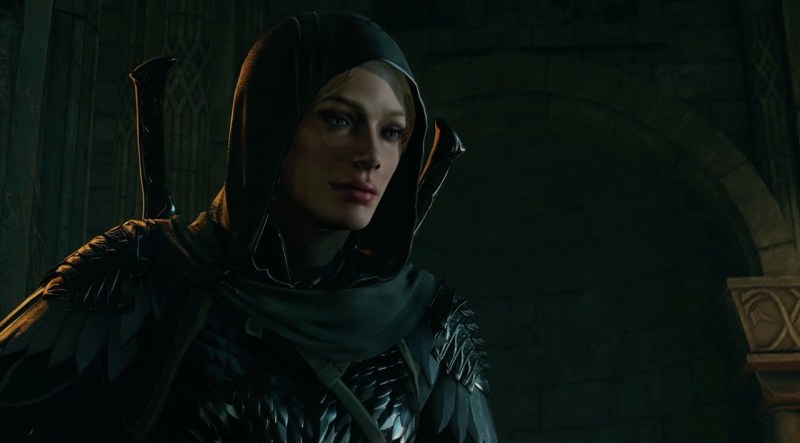
Shadow of Mordor had a big open world, but the world of Shadow of War is about three times bigger, with a huge density of missions and tasks to perform. I have counted more than 63 missions, not counting a bunch of Nemesis Orc duels and Celebrimbor’s reminiscences about the history of the One Ring during the Second Age.
The single-player campaign is gigantic, with eight types of campaign missions, and you unlock these as you progress through the story. You start out in Minas Ithil, and you bear witness to how it become Minas Morgul, which is a compelling narrative that feels like the main thread. You can find diversions in the forest of Carnan which eventually unlock the missions of the elf woman warrior, Eltariel, and it is her story that leads us to the conclusion of the main tale. You also get a final cut scene at the end of the Siege Battle missions, and it comes after a long slog through the fortress battles.
Each mission can take a half hour or more, not counting the time it takes to replay it if you fail. And I failed a lot. Just when I thought I was done with a campaign thread, new missions appeared in the other parts of the campaign. For people who want a near-endless campaign, this is a good thing. For those who want a straight shot through the story, it can be annoying.
The story fits Tolkien’s style
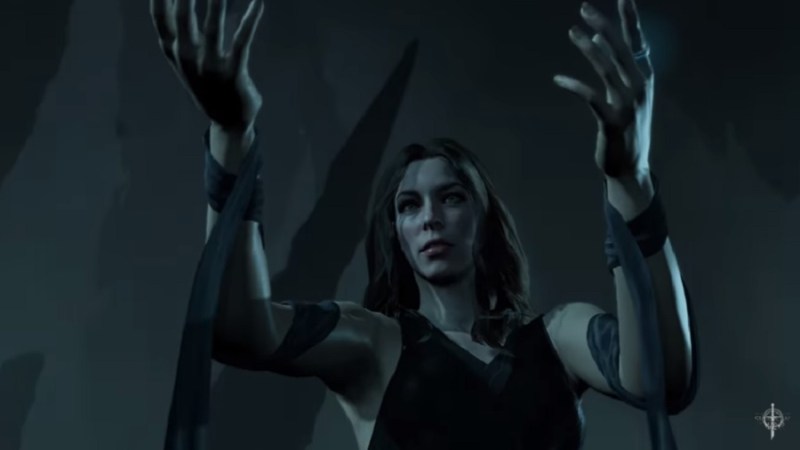
Above: Shelob tempts Talion in Middle-earth: Shadow of War.
I think the tale of Talion has some brilliant aspects. In the last game, Monolith showed that it could extend the Tolkien universe to new characters that I really cared about, like Celebrimbor and Talion. It introduced a plot to save Middle-earth by delaying Sauron’s advances and giving the people of Gondor and other regions more time to come to their senses and mount a defense ahead of the events of The Lord of the Rings. Just what was Sauron doing during the time between the novels, where he should have just been marching on Middle-earth? Well, he was dealing with Talion’s Orc civil war.
Talion’s story fits in the space between some of the best epic stories of all time. It is more than just filler. It is a new part of the universe. It is a tale that on its own is strong enough to become a new piece of the lore.
I love how the story has some major plot twists. In one thread of the narrative, you think a character is leaving the story line. But the writers find a way to bring that character back from the dead. That theme of bringing someone back from the dead occurs over and over in the game, from the Orc captain chatter to a campaign with a new character named Zog. In this narrative, you ask yourself what Talion will sacrifice to accomplish his aims and who will betray him in the end.
Massive sword fights and Siege Battles
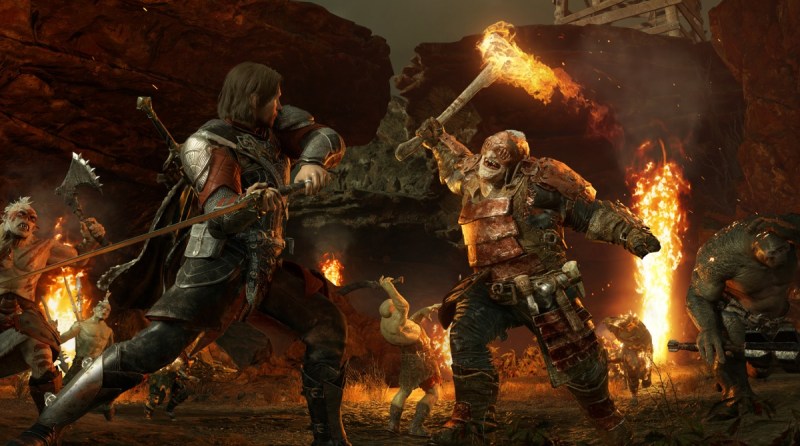
Above: Reviews editor Mike Minotti claims he has more Tolkien knowledge than me. We’ll duke it out.
In a Siege Battle for control of a city, you have to capture victory points. Minion Orcs spawn by the dozens, crowding the battlefield. But at the victory points, both sides converge, with Orc captains on the Dark Lord’s side facing off against the Talion. Some moments are so crowded in the battle that you can’t see who you’re facing. So you take a swing with your sword, and you may hit someone else. It’s an intense battle for control, with all sorts of battle chatter and the clanging of metal. I loved the intensity of these battles, where the stakes are high and the results always unpredictable.
You have to demonstrate a lot of skill fighting these battles. Sometimes you wade into the thick of it with a sword. But other times, you think about it and ride a fire-breathing dragon into the battle instead. In each Siege Battle for control of a city, you have to take these victory points and drive to the keep. There, you fight the overlord of the fortress. If you defeat the boss, you take control of the city. If you fail, then you lose the city and have to take it once again, after the overlord becomes an even harder target.
The Siege Battles feature some really great diversions, like riding a drake around (a little too hard to control) and spraying fire down below. And it’s fun to get on siege catapult atop a giant Graug and rain artillery fire on the fortress.
The Orcs have personalities
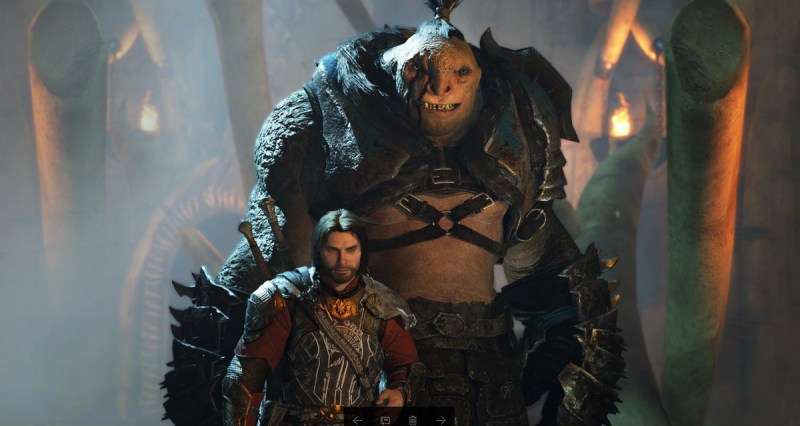
Above: A man and his troll.
The Orc captains always talk trash before they fight a duel with Talion. They are part of the Nemesis system, which tracks whether you have encountered an Orc before and triggers a piece of dialogue, such as, “I killed you once, and I’ll kill you again.” With Nemesis, you can encounter an Orc in one battle, lose the fight, and see the Orc promoted to a higher and more powerful level. It becomes that much harder to defeat the Orc the next time.
I loved meeting these Orcs, hearing their annoying insults, defeating them in battle, and subjugating them as my own subjects. I would humiliate an Orc captain and see his swagger change from bravado to whimpering. I would appoint an Orc as a warchief or an overlord for a castle, and then the Orc would betray me and turn on me because that’s the way that Orcs behave. Some of the captains, like Ratbag, become funny sidekicks. And when I lost some of them in battle, I felt sad.
What you won’t like
Some story flaws and lore violations
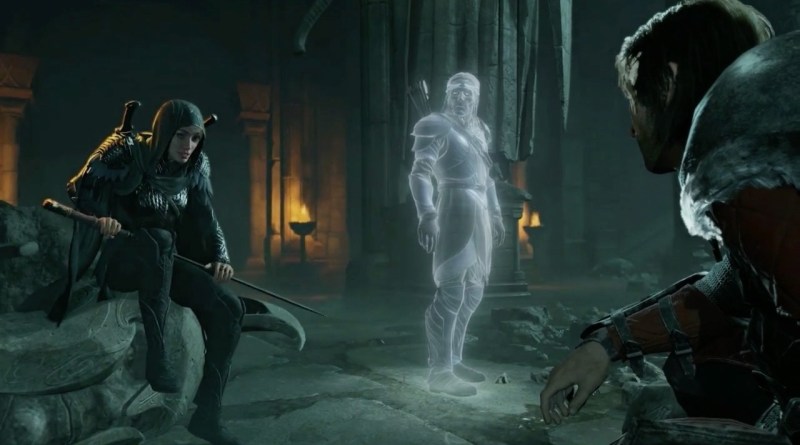
Above: Eltariel, Celebrimbor, and Talion the Bright Lord in Shadow of War.
Monolith introduces interesting characters like Shelob, inserting the giant spider into the story as a kind of temptress in women form. Only four Shelob-related missions involve an event of intense gravity that I won’t spoil. It seemed like Shelob should have been woven into more of the story, as her role in the story was fascinating. But the writers of the narrative also made a strange oversimplification in their tale that parted paths from the Tolkien lore.
Some violations in Tolkien lore happen early on in the game. It isn’t too serious, but I’m not sure why Monolith’s writers chose to oversimplify the Last Alliance of Elves and Men. Celebrimbor, the wraith in Shadow of War, was a great elven smith of the Second Age, when Sauron came to power. Celebrimbor made the rings of power and taught Sauron his craft. But Sauron forged the One Ring on Mount Doom in Mordor, as the One Ring to control all the others. When the elves and men discovered their danger, they gathered under the banners of Elf lord Gil-Galad and Elendil of the men of Numenorean descent. They led the Last Alliance of Elves and Men against Sauron, and they were victorious. In the Peter Jackson films, the film shortened this to show Elrond as one of the elf leaders. But in a Shadows of the Past mission in Shadow of War, we are told that it was Celebrimbor’s war against Sauron. That’s simply not true. Celebrimbor may have played a role, but he was not a war leader.
Then, a bizarre turn of the story goes unexplained for a long time. Shelob says something early on that seems like an ominous warning to Talion. She says to Celebrimbor that “you and Sauron are one.” That’s a twist that could make a lot of sense, as Sauron is known as the Great Deceiver, and Celebrimbor the wraith may be pulling the wool over Talion’s eyes. But we don’t get to follow up on this accusation at all, because Talion never asks Celebrimbor what Shelob meant by that remark. That seems a little too implausible, even if the lack of a query is convenient.
These might seem like nitpicks. But the bigger problem is that the grand story narrative isn’t woven through all of the missions, especially the Siege Battles. About three of the eight major campaigns focus on the story of Talion, Shelob, Celebrimbor, and the elf Eltariel, a new character.
I would rather have seen this story have a much greater arc, stretching across all of the campaigns and bringing them into the drama that keeps you going. After I finished a few of the campaigns, I didn’t really feel like finishing the rest of them. That’s because I felt I had already gotten through the true ending of the game.
It’s a small world after all
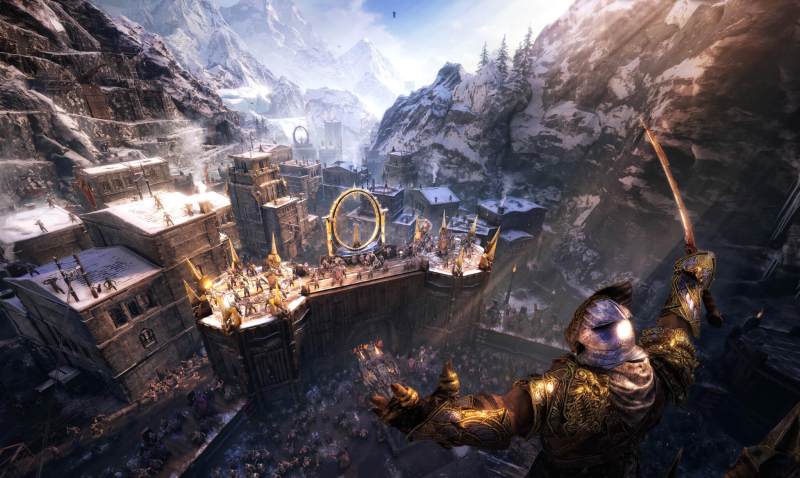
Above: Yours for the taking.
Despite the large and enticing map of Mordor, you can’t go everywhere you see a fortress. It just has five locations where you can explore: Minas Ithil, Cirith Ungol, Seregost, Nurnen, and Gorgoroth. And of those, the latter three are completely new imagined fortresses, as they weren’t described in Tolkien’s world. I imagine that Monolith will be able to add new fortresses as DLC. But it was a bit of a disappointment when I figured out that I couldn’t visit every marked location.
And this leads to a larger problem, where you go over familiar ground many times. I fought for control of the five fortresses many times (as many as 10 times, since the fortresses change hands and you most both attack them or defend them). While I enjoyed the battles, I resented being forced to fight for them over and over. You can have different outcomes with different Orc captains, and that makes the missions replayable. But these were devoid of any story relevance, and they turned out to be a grind in the long hard slog to finish the game. It starts to feel a lot like padding aimed at making sure you get your $60 worth of gameplay.
Some bugs need fixing
I played an early version of the game for the PS4. I ran into frequent clipping problems, where a character runs into an object that they shouldn’t be able to do. Like a character becoming part of a stone instead of standing next to it. Hopefully Monolith will fix these bugs by launch day. You may notice some flaws, but they aren’t showstoppers and may not be there in the final version.
Time is your enemy
Sauron’s forces have a habit of wearing you down, and it’s annoying to fight them over and over again. It’s not easy recruiting Orc captains to your side. You have to fight them in combat and break their morale. Once you do, you can recruit them. But some are ranked too high above you to be recruited, and some need to be humiliated, so their ranking comes down and they can be recruited after a second battle. Too often, I wound up killing the broken captains, applying too much force when I wanted to recruit them to my side instead. Some of the captains can’t be recruited. So the simple task of getting more captains on your side for a big battle takes a lot of rinse-and-repeat action.
Running places is a drag
Running fast is an improvement over the slow running in Shadow of Mordor. But the problem with running fast on the PS4 is that I have to push the left stick down often and press the X button at the same time to sprint. And the problem with sprinting is that it takes a while to run to a spot where I can join a mission. Why can’t I just skip the running and join a mission directly? This is a part of the user interface that, along with the long loading times, makes the game stretch out forever. You can fast travel between some parts of the map, but you still have to do a lot of running that simply isn’t fun. Call me a couch potato gamer, but I got tired of running.
Conclusion
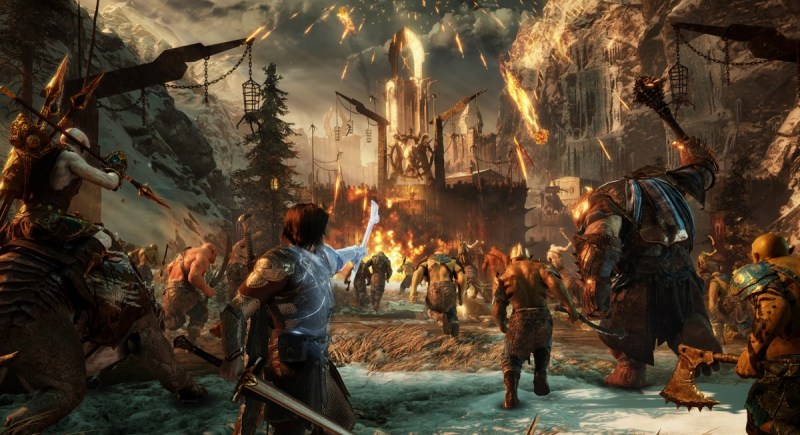
Above: Fortresses get bigger and harder to take over as you progress into Shadow of War.
Middle-earth: Shadow of War is a huge open world, but it is more of a grind than it should be. It is a towering achievement that lives up to its hype. Monolith seemed to oversell a few features, like the idea of Orc tribes. You see a lot of internecine combat among Orcs, but I didn’t notice any clear factions. The story has a lot of gravity, but it sadly doesn’t stretch across all of the campaigns. I wished Monolith brought more structure to that narrative. And, as I’ve pointed out, a number of flaws make the experience fall short of the kind of impact that the game could have had.
It sets up a challenge for Monolith to do better in the next game. I’m looking forward to getting more of the story of Talion’s tragedy. We know it’s going to end in a sad way, since Talion has been erased from the history books by the time of the The Lord of the Rings. I just hope that the storytellers make the journey both heart-rending and memorable. They’re standing on the edge of greatness now, and I hope the next game will fulfill the destiny of making Talion’s story a part of the Tolkien canon.
Score: 87/100
Middle-earth: Shadow of War came out for PC, Xbox One, and PlayStation 4 on October 10. Warner Bros. sent us a PS4 code for the purposes of this review.
